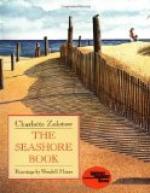Now let us leave the beach and look for the Redshank on the mud-flats. Many birds would starve there, but the Redshank is quite happy, as Nature has fitted him for his life in such a place. His long, red legs—from which he gets his name—are for wading in the shallow, muddy creeks he loves. Those wide-spreading feet keep him from sinking in the mud.
The long beak is for probing. As a rule the Redshank digs for his dinner, though he also picks up any worms or other food on the surface; but he is nearly always seen probing the mud.
Like all the shore birds, Redshanks are very wary. They have no hedges or trees for hiding-places, and so must always be on the watch. No sooner does the Redshank spy you than he is up and, with a shrill whistle of alarm, flies quickly away.
The marshes are the home of many a bird like the Redshank. They are all waders and diggers. They live much as he does, and so they have the long beak and legs, and the spreading feet, to fit them for that life.
We have now looked at a few sea birds, shore birds, and a marsh bird. Many inland birds, too, are fond of the shore. The artful Jackdaw builds in the cliffs, and his cousin, the Crow, searches the shore for food. Even the gay Kingfisher has been seen diving in the seaside pools.
EXERCISES
1. How do you know which is the Black-headed Gull in the summer months?
2. Why is it difficult to see the Ringed Plover on the stones of the shore?
3. Where would you look for the eggs of the Ringed Plover and of the Black-headed Gull?
4. Why have marsh birds such long beaks?
LESSON IV.
CRABS.
Little Crabs are to be found everywhere along the sea-shore—not the monsters of the fishmonger’s shop, but small greenish-brownish Crabs. They live in the weed of the rock-pools, and in the wet sand. These are the Shore Crabs; the large Edible Crabs are a different kind, and live mostly in deep water.
Shore Crabs are quarrelsome little creatures; the larger ones are always ready to gobble up the smaller ones, or to snatch their food and run away with it. If you put some dead mussels or fish in a pool, you will be amused at their antics. How they scramble and fight! Crabs do not believe in “table manners.”
[Illustration: The Redshank.]
[Illustration: The crab.]
It is their taste for waste scraps of food that makes crabs of use in the sea. They are most useful scavengers. They clear the sea and beach of dead matter which would poison the air and water.
For many years nobody knew how Crabs grew up. It was thought that a baby Crab was like its mother, just as a baby spider is a tiny picture of its parent. But no, the young Crab is as much like a Crab as a caterpillar is like a butterfly.




